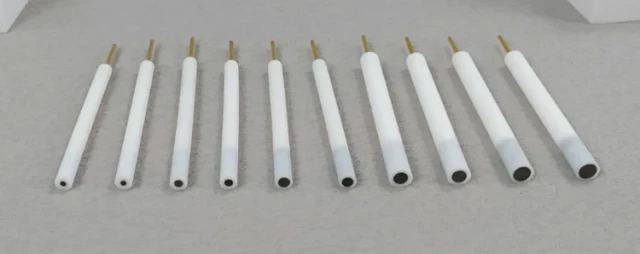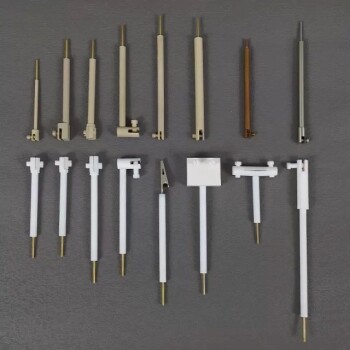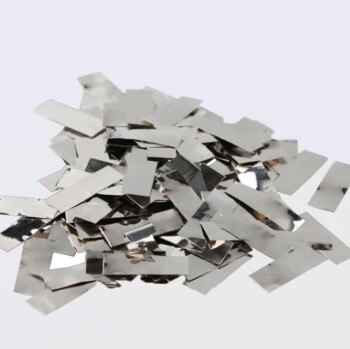Introduction to Electrolytes and Electrodes
Electrolytes and electrodes play an essential role in electrochemistry. Electrolytes are substances that conduct electricity when dissolved in water or melted. Electrodes, on the other hand, are conductors that transfer electrons to or from an electrolyte. They facilitate the conversion of chemical energy into electrical energy through redox reactions. Electrodes are made of different materials, such as metals, metal oxides, and carbon. Each type of electrode has unique properties that affect how they function in electrochemical cells. Understanding the mechanics and processes of electrolytes and electrodes is crucial for designing and optimizing electrochemical systems.
Table of Contents
- Introduction to Electrolytes and Electrodes
- The Mechanics and Processes of an Electrode
- Composition of Electrodes and Examples
- Types of Electrolytes and Commonly Used Ones
- Electrolytic Cells and Electrolysis
- Two Types of Electrochemical Cells: Voltaic and Electrolytic
- The Purpose and Function of a Salt Bridge
The Mechanics and Processes of an Electrode
Electrolytes are substances that conduct electricity when dissolved in water or melted. Electrochemical electrodes are devices that facilitate electrochemical reactions by allowing electrons to flow between an electrode and an electrolyte. An electrode by definition is a point where current enters and leaves the electrolyte. When the current leaves the electrodes, it is known as the cathode, and when the current enters, it is known as the anode.

Electrode Materials and Conductivity
Electrodes are made of conductive materials such as metals or carbon that can transfer electrons. An electrode has to be a good electrical conductor so it is usually a metal. The type of material used in the electrode affects the conductivity and the efficiency of the reaction. Some commonly used inert electrodes include graphite (carbon), platinum, gold, and rhodium. Some commonly used reactive electrodes include copper, zinc, lead, and silver.
Processes of an Electrode
When an electrode is in contact with an electrolyte, the electrode potential can either attract or repel electrons from the electrolyte. This can cause oxidation or reduction reactions to occur, leading to the transfer of electrons and the generation of an electric current. An electrode is a metal whose surface serves as the location where oxidation-reduction equilibrium is established between the metal and what is in the solution. The electrode can either be an anode or a cathode.
An anode receives current or electrons from the electrolyte mixture, thus becoming oxidized. When the atoms or molecules get close enough to the surface of the electrode, the solution in which the electrode is placed into donates electrons. This causes the atoms/molecules to become positive ions.
The opposite occurs with the cathode. Here the electrons are released from the electrode and the solution around it is reduced.
Standard Hydrogen Electrode
A Standard Hydrogen Electrode (SHE) is an electrode that scientists use for reference on all half-cell potential reactions. The value of the standard electrode potential is zero, which forms the basis one needs to calculate cell potentials using different electrodes or different concentrations.
Electrodes in Batteries
Electrodes can be used in a variety of applications, such as batteries, fuel cells, and sensors. In batteries, electrodes pass on energy to and from the electrolyte to power the polarized device they connect. This energy departs from the battery through the negatively charged anode and proceeds through the device. Then it returns via the positively charged cathode, thereby bringing down the power stored through reduction.
Electrodes in Electrolysis
Electrolysis is a process used to differentiate a substance into its original components or elements. Electrodes are immersed and separated at a distance. A current goes between them through the electrolyte and is connected to the power source, which completes the electrical circuit. During electrolysis, the anions are attracted to the positive electrode (anode), where they lose electrons to form atoms or molecules. We say that the anions are discharged. Oxidation has occurred at the anode. The electrons flow to the positive terminal of the battery, then to the negative terminal before entering the electrolyte through the cathode. At the negative electrode (cathode), the cations in the electrolyte are attracted to it, where they receive/gain electrons to also form atoms or molecules. The cations are discharged. Reduction has occurred at the cathode.
In conclusion, understanding the mechanics and processes of electrodes is crucial in developing new technologies and improving existing ones. Electrodes play a vital role in many areas of science and technology, from batteries to electrolysis to sensors. With the right electrode materials and design, we can create more efficient and effective electrochemical reactions.
Composition of Electrodes and Examples
Electrodes play a crucial role in various scientific and industrial processes involving electrochemistry. They are made of conductive materials such as metals, graphite, or carbon, and are used to transfer electrons between the electrolyte and an external circuit. The composition of the electrode greatly affects its performance and determines its suitability for specific applications.

Electrode Composition
Electrodes are typically made of metals, graphite, or carbon. Platinum electrodes are commonly used in electrochemical sensors and fuel cells due to their stability and resistance to oxidation. Carbon electrodes are often used in electrochemical analysis and silver-silver chloride electrodes are used in pH measurement.
Inert electrodes such as platinum and graphite do not interfere or participate in any chemical reactions that may occur during the electrochemical process. In contrast, reactive electrodes such as copper, silver, and gold take part in the reaction taking place in the cell and can disassociate in the electrolyte.
Electrode Examples
In analytical chemistry, gold, platinum, and amorphous carbon are typical materials used for electrodes. Glass electrodes are often used in pH measurements, and in this application, the glass is chemically doped to be selective to hydrogen ions.
Batteries contain a variety of electrodes, depending on the battery type. Lead-acid batteries are based on lead electrodes, zinc-carbon batteries have zinc and amorphous carbon electrodes, and lithium polymer batteries have electrodes made of a solid polymer matrix within which lithium ions can move and act as charge carriers.
In electrolysis, various metals can be extracted using different types of electrodes. In the Hall-Heroult process to extract aluminum metal from aluminum oxide, both the anode and cathode are made of graphite. Sodium metal is produced by electrolysis using a carbon anode and an iron cathode.
Conclusion
In conclusion, the composition of electrodes can have a significant impact on their performance, and different electrode materials are chosen depending on the application. Inert electrodes such as platinum and graphite do not participate in any chemical reactions, while reactive electrodes such as copper, silver, and gold take part in the reaction taking place in the cell and can disassociate in the electrolyte. Electrodes are used in various scientific and industrial processes, including batteries, electrolysis, and electrochemical analysis.
Types of Electrolytes and Commonly Used Ones
Electrolytes are substances that conduct electricity when dissolved in water or melted. They play a crucial role in the functioning of electrochemical cells, which are devices that convert chemical energy into electrical energy or vice versa. There are different types of electrolytes, including strong and weak electrolytes, as well as non-electrolytes.

Strong Electrolytes
Strong electrolytes dissociate completely into ions when dissolved in water. Examples of strong electrolytes include sodium chloride, potassium chloride, and sulfuric acid. Strong electrolytes conduct electricity well because they form many ions that can move freely in the solution.
Weak Electrolytes
Weak electrolytes only partially dissociate when dissolved in water. Examples of weak electrolytes include acetic acid and ammonium hydroxide. Weak electrolytes conduct electricity poorly because they form relatively few ions that can move freely in the solution.
Non-Electrolytes
Non-electrolytes do not dissociate at all when dissolved in water. Examples of non-electrolytes include glucose, sucrose, and ethanol. Non-electrolytes do not conduct electricity because they do not form any ions in solution.
Commonly Used Electrolytes
Commonly used electrolytes in laboratory settings include sodium chloride, potassium chloride, and sulfuric acid. These electrolytes are often used in electrochemical electrodes, which are devices that are used to measure electrical potential or current.
Sodium Chloride
Sodium chloride, also known as table salt, is a strong electrolyte that dissociates completely into sodium and chloride ions when dissolved in water. It is commonly used as a reference electrolyte in electrochemical cells.
Potassium Chloride
Potassium chloride is a strong electrolyte that dissociates completely into potassium and chloride ions when dissolved in water. It is commonly used as a reference electrolyte in electrochemical cells.
Sulfuric Acid
Sulfuric acid is a strong electrolyte that dissociates completely into hydrogen and sulfate ions when dissolved in water. It is commonly used as an electrolyte in lead-acid batteries and is also used in various industrial processes.
Overall, understanding the different types of electrolytes and their properties is important for anyone working in the field of laboratory equipment. The choice of electrolyte depends on the specific application and the desired level of accuracy.
Electrolytic Cells and Electrolysis
Electrolytic cells are electrochemical cells that use electrical energy to drive non-spontaneous redox reactions. The three main components of an electrolytic cell are the cathode, anode, and electrolyte. The electrolyte is typically a dissolved ion solution in water or other solvents, and it provides the medium for the exchange of electrons between the cathode and anode.

How Electrolysis Works
Electrolysis is a process in which an electric current is passed through a solution or molten substance containing ions, causing the substances inside to decompose. To sustain an electrolytic reaction, a complete circuit is required, and the ions must be able to move. In electrolytic cells, we use a direct current power source, meaning that the electrodes are always either positive or negative.
Components of Electrolytic Cells
The cathode is the negatively charged electrode in an electrolytic cell, while the anode is the positively charged electrode. Anions in the electrolyte travel toward the anode and are oxidized, while cations in the electrolyte travel toward the cathode and are reduced. The electrolyte used in electrolytic cells is typically a salt solution or a molten salt.
Applications of Electrolytic Cells
Electrolytic cells have numerous applications, including the production of oxygen gas and hydrogen gas from water, the extraction of aluminum from bauxite, and the electrorefining of many non-ferrous metals. Electrolytic cells are also used in electroplating, which is the process of forming a thin protective layer of a specific metal on the surface of another metal. The industrial production of high-purity copper, high-purity zinc, and high-purity aluminum is also almost always done through electrolytic cells.
Electrolysis of Sodium Chloride
Molten sodium chloride (NaCl) can be electrolyzed using an electrolytic cell, with two inert electrodes immersed in the molten salt. When an electric current passes through the circuit, the cathode becomes rich in electrons and develops a negative charge. The positively charged sodium cations are attracted toward the negatively charged cathode, resulting in the formation of sodium metal at the cathode. At the same time, chlorine atoms are attracted toward the positively charged anode, resulting in the formation of chlorine gas (Cl2) at the anode, accompanied by the release of two electrons to complete the circuit. The overall cellular reaction is 2NaCl → 2Na + Cl2.
In conclusion, electrolytic cells and electrolysis play a crucial role in electrochemistry, with numerous applications in industry and technology. Understanding the properties and behavior of electrolytes and electrochemical electrodes is essential in developing new technologies and improving existing ones.
Two Types of Electrochemical Cells: Voltaic and Electrolytic
Electrochemical cells are devices that generate electrical energy from chemical reactions occurring within them. These cells are of two types: voltaic and electrolytic.
Voltaic Cells
Voltaic cells, also known as galvanic cells, produce electrical energy from a spontaneous redox reaction. The anode undergoes oxidation, while the cathode undergoes reduction. Electrons flow from the anode to the cathode through an external circuit, producing an electrical current. Voltaic cells convert chemical energy into electrical energy.
Electrolytic Cells
Electrolytic cells require an external electrical source to drive a non-spontaneous redox reaction. The anode is the positive electrode, and the cathode is the negative electrode. The electrolyte solution contains ions that migrate towards the electrodes, where they undergo oxidation or reduction. Electrolytic cells convert electrical energy into chemical energy.
Differences Between Voltaic and Electrolytic Cells
The main difference between voltaic and electrolytic cells is the source of electrical energy. Voltaic cells generate electrical energy from a spontaneous redox reaction, while electrolytic cells require an external electrical source to drive a non-spontaneous redox reaction. Another difference is the direction of electron flow. In voltaic cells, electrons flow from the anode to the cathode through an external circuit, while in electrolytic cells, electrons flow from the cathode to the anode through an external circuit.
Applications of Electrochemical Cells
Electrochemical cells have a wide range of applications, such as in batteries, fuel cells, and sensors. Voltaic cells are used in batteries to power devices such as TV remotes and clocks. Electrolytic cells are used in the electroplating and purification of metals such as copper. Fuel cells use electrochemical reactions to convert chemical energy into electrical energy, and they are used to power electric vehicles. Sensors use electrochemical reactions to detect and measure the concentration of various substances.
In conclusion, electrochemical cells are devices that generate electrical energy from chemical reactions occurring within them. There are two types of electrochemical cells: voltaic and electrolytic cells. Voltaic cells convert chemical energy into electrical energy, while electrolytic cells convert electrical energy into chemical energy. These cells have a wide range of applications in various fields such as batteries, fuel cells, and sensors.
The Purpose and Function of a Salt Bridge
In electrochemical experiments, electrolytes and electrochemical electrodes are important components. Electrolytes conduct electricity when dissolved in water or other solvents, while electrochemical electrodes facilitate electron transfer between a solution and an electrode. These two components combine to form an electrochemical cell. A salt bridge is a critical part of this setup, as it allows the flow of ions between the two compartments of the cell, maintaining a balance of charges.
What is a Salt Bridge?
A salt bridge is typically made up of an inert electrolyte with a high concentration of ions, such as potassium chloride. The purpose of the salt bridge is to prevent the buildup of charge in either compartment, which would interfere with the chemical reaction taking place. It achieves this by continuously exchanging ions between the two compartments, thus preventing the buildup of charge and maintaining the stability of the electrochemical cell.
How does a Salt Bridge work?
As electrons flow from one half-cell to the other through an external circuit, a difference in charge is established. If no ionic contact were provided, this charge difference would quickly prevent the further flow of electrons. A salt bridge allows the flow of negative or positive ions to maintain a steady-state charge distribution between the oxidation and reduction vessels, while keeping the contents otherwise separate.
Components of a Salt Bridge
A salt bridge is made up of an electrolyte and a cell separator. The electrolyte is the solution that contains ions, while the cell separator is the material that separates the two compartments of the electrochemical cell. The cell separator could be a glass tube bridge, which is a tube that has a U-shape and is filled with electrolytes like sodium chloride and potassium nitrate. The filter paper bridge is another type of separator that is formed by a porous material such as filter paper that has electrolytes soaked.
Importance of Salt Bridge
The salt bridge plays a critical role in electrochemical experiments, allowing for the continuous flow of ions and maintaining the stability of the electrochemical cell. The solution in the salt bridge must be inert and nonreactive with other solutions. This prevents a reaction between the solution and the salt bridge and allows movement of ions between the two half-cells.
Related Products
- Gold Electrochemical Sheet Electrode Gold Electrode
- Electrolytic Electrochemical Cell for Coating Evaluation
- Electrode Fixture for Electrochemical Experiments
- Platinum Sheet Electrode for Laboratory and Industrial Applications
- Rotating Platinum Disk Electrode for Electrochemical Applications
Related Articles
- A Comprehensive Guide to Reference Electrodes
- Reference Electrodes: Calomel, Silver Chloride, and Mercury Sulfate - A Comprehensive Guide
- Understanding Electrodes and Electrochemical Cells
- Understanding Electrodeposition with Electrochemical Electrodes
- Electrode Materials for Rotating Ring-Disk Electrodes













